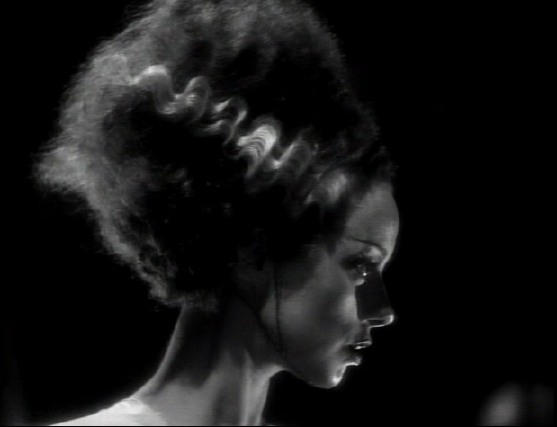I had a lot of fun last week with the Bride of Frankenstein 75th Anniversary series.
I’m very grateful for all the encouraging comments I got here, on Facebook and email. Thanks very much!I dug up so much new material I think I could have posted every day for a month, so expect a lot of Bride-related art and articles over the next few days and weeks. I’ve added a Bride badge to the right-hand menu. Clicking it will access all the Bride of Frankenstein posts on this blog.
Here, if I may, is something from the Frankensteinia archives that I think deserves reposting. It’s a revised version of my contribution to Matt Zoller Seitz’ Close-Up Blogathon.

When a reluctant James Whale was finally persuaded to make a sequel to his Frankenstein (1931) — on the express condition that he be given complete artistic freedom — he traded the original’s raw, claustrophobic expressionism for lavish Hollywood Golden Age glamour.
The Bride of Frankenstein (1935) is awash is pearly grays and deep focus photography. The sets have grown cavernous and meticulously detailed. Heroic music punctuates every scene. Colin Clive, as the manic-depressive Frankenstein, interacts with the formidable Ernest Thesiger as the most eccentric, eldritch mad scientist of them all. The Monster has lost his malevolent gauntness. He speaks, cultivates a taste for wine and cigars, sheds tears, and pines for a friend.
Into this heady mix is introduced The Bride, only to signal a quick, catastrophic end to this macabre fairy tale.

The part of the fabricated Bride fell, magnificently, to Elsa Lanchester, who also played Mary Shelley in the film’s prologue, connecting Mary and The Bride. The comparison is made clear and unmistakable: In the opening sequence, a delicate Mary reaches for her beloved Percy, turning her back to the obnoxious Lord Byron, a balletic move directly echoed when the frightened Bride reaches for Henry Frankenstein, turning away from the lugubrious Dr. Pretorius.


The entire lifespan of the Monster’s betrothed, from the moment we see her fingers move until The Monster pulls the Deus Ex Power Switch that blows everything to atoms, is almost exactly 12 minutes. Add a few moments, unshown, while Frankenstein and Pretorius remove the head bandages and slip her into a tent-like shroud. I’d like to think that The Bride’s electrostatic hairdo sprang up on its own as soon as the bandages unraveled. Otherwise, the entire, short existence of the thunderstruck Bride is chronicled on screen, most of it in tight, loving close-up.
The Bride’s profile was inspired by a bust of Nefertiti, which is appropriate for a Monster Queen. She is unforgettable, with her electrified hair, bee stung lips, lightning bolt neck scars and big eyes, irises the size of dimes, that never seem to blink.
Here’s my homage to The Bride, as she appeared in close-up, from the shot of her bandaged head with its crown of safety pins to her final, defiant hiss.
I give you The Beautiful Monster: The Bride of Frankenstein.
Directed by James Whale. Makeup by Jack Pierce. Cinematography by John Mescall.
Related:
Off With The Kites!: The creation scene from The Bride of Frankenstein.
Into The Light: The Monster Revealed.














6 comments:
Those are some awesome pics.
The photos are awesome. But it's when I watched Lanchester in action that the character really grabbed me. The Bride is twitchy and feral, a creature that isn't quite awake yet and isn't enjoying the waking up process.
I wonder what we'd have seen if the Bride had lived longer in a sequel or a longer movie?..Lots of love triangle humor with the Monster getting jealous and pissy over the Bride not returning his affections?A sequence like the one with Jane Seymour in Frankenstein:The True Story?,which I thought would have made a good movie in itself...
Elsa Lancaster studied dance under Isadora Duncan when she was a child. I saw an interview with her in her later years where she described the divine Isadora's pretensions. But this would explain the "balletic move."
Christopher: Lanchester said she would have gladly agreed to a sequel.
hra: Good catch. Isadora Duncan is mentioned in my previous Elsa posts: http://frankensteinia.blogspot.com/search?q=isadora
Great, great black and white...
Post a Comment